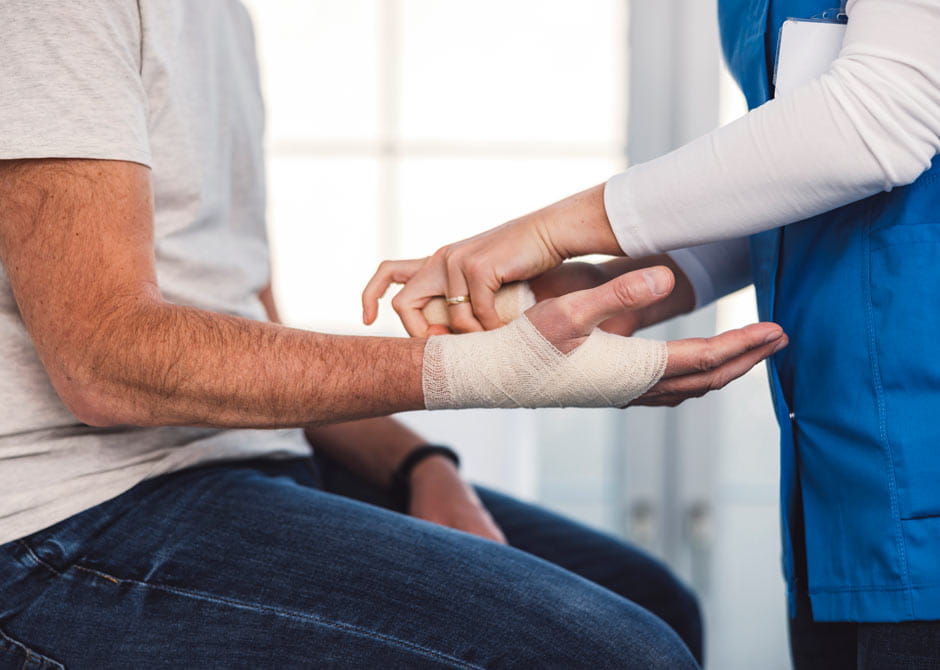 What is a broken hand and what is a broken wrist?
What is a broken hand and what is a broken wrist?
A broken hand happens when any one of the more than two dozen bones in your hand is fractured. Hand fractures are some of the most common broken bones.
A broken wrist, sometimes called a Colles’ fracture, occurs when any of the eight small bones between your hand and forearm are fractured.
Unfortunately, both hand injuries can cause significant pain and limit your ability to use your hand and wrist effectively until healed.
You’ll likely need to wear a splint or cast for several weeks while your bones heal. In severe cases, your doctor may recommend hand surgery to repair the fracture in your hand or wrist, or occupational therapy may be needed to regain strength and function.
The orthopedic specialists in the Hand and Upper Extremity Care Team at The Ohio State University Wexner Medical Center in Columbus, Ohio, are experts at diagnosing the severity of your broken hand or wrist and which type of treatment might be best for you. We’ll have you back to enjoying life and your favorite activities in no time.
How do these injuries happen?
Broken hands and broken wrists are usually due to falls, sports injuries or accidents. For example, you might break your hand or wrist if you fall and try to brace yourself with an outstretched hand. Car accidents can also cause these injuries.
What are the symptoms of a broken hand?
The most common symptoms of a broken hand can include:
- Severe pain and tenderness
- Swelling
- Bruising or discoloration
- Difficulty moving your hand, fingers or thumb
- A bump or noticeable deformity on your hand
What are the symptoms of a broken wrist?
Symptoms of a broken wrist can include:
- Pain, especially when moving your wrist
- Swelling
- Bruising or discoloration
- Deformity of the wrist, causing it to look crooked or bent

Why broken bones are a big deal in adulthood
Carmen Quatman, MD, PhD, an orthopedic surgeon, explains why broken bones not only take longer to heal, but they can also signal bigger issues as you age.
How is this injury diagnosed?
To diagnose a broken hand or broken wrist, your doctor will ask about your symptoms and how the injury occurred.
Your doctor will have you get imaging tests, such as X-rays, to get a clear view of the bones and determine the extent of the fracture. You may need several sets of X-rays, as the fracture can sometimes be difficult to fully see at first.
Seek treatment to avoid complications
Having a broken hand or broken wrist is fairly common. Seeking prompt treatment from an orthopedic specialist is essential to ensure you avoid any complications down the road. Without proper treatment, you may risk the following:
- Chronic pain due to bones healing incorrectly
- Stiffness and limited range of motion
- Increased risk of developing arthritis in the affected joint
- Nerve or blood vessel damage
What are the treatment options for broken hand or broken wrist?
Treatment for a broken hand or wrist depends on the severity and location of the fracture. In most cases, surgery isn’t needed to fix a broken hand or wrist.
Nonsurgical options
Nonsurgical treatments include:
- Immobilization: Your doctor may use a cast, splint or brace to keep the bones in place while they heal. This option is ideal if you have a mild broken hand and your bones didn’t move far out of place. You’ll likely need to have the injury immobilized for three to six weeks.
- Closed reduction: If you have a more severe broken hand or wrist, your doctor may need to set (realign) your bones by physically pushing on the outside of your hand. Because of the pain involved, you’ll be given a local anesthetic or sedative. After the procedure, your hand and wrist will be placed in a cast or splint.
Surgical options
If you have a severe broken hand or broken wrist, your doctor may recommend surgery. This is sometimes the case if you have an open/compound fracture (bone breaking through your skin) or a bone that is broken in more than two places.
- Open reduction and internal fixation (ORIF): This procedure involves making an incision to access the broken bones, then using metal plates, screws or pins to hold the bones in place while they heal.
- External fixation: In this procedure, metal pins or screws are inserted into the bone and connected to a metal frame outside the skin. This frame helps keep the bones in the correct position during healing.
Recovery or healing time from a broken hand or broken wrist
Your recovery time for a broken hand or wrist can vary, depending on the severity of the fracture and the treatment received. Generally, it takes about six to eight weeks for the bones to heal. However, it may take several months for you to fully regain strength and function in your hand or wrist.
